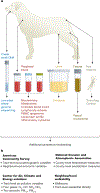An open science study of ageing in companion dogs
- PMID: 35110758
- PMCID: PMC8940555
- DOI: 10.1038/s41586-021-04282-9
An open science study of ageing in companion dogs
Erratum in
-
Author Correction: An open science study of ageing in companion dogs.Nature. 2022 Aug;608(7924):E33. doi: 10.1038/s41586-022-05179-x. Nature. 2022. PMID: 35941194 No abstract available.
Abstract
The Dog Aging Project is a long-term longitudinal study of ageing in tens of thousands of companion dogs. The domestic dog is among the most variable mammal species in terms of morphology, behaviour, risk of age-related disease and life expectancy. Given that dogs share the human environment and have a sophisticated healthcare system but are much shorter-lived than people, they offer a unique opportunity to identify the genetic, environmental and lifestyle factors associated with healthy lifespan. To take advantage of this opportunity, the Dog Aging Project will collect extensive survey data, environmental information, electronic veterinary medical records, genome-wide sequence information, clinicopathology and molecular phenotypes derived from blood cells, plasma and faecal samples. Here, we describe the specific goals and design of the Dog Aging Project and discuss the potential for this open-data, community science study to greatly enhance understanding of ageing in a genetically variable, socially relevant species living in a complex environment.
© 2022. The Author(s), under exclusive licence to Springer Nature Limited.
Figures



References
-
-
Kaeberlein M, Rabinovitch PS & Martin GM Healthy aging: the ultimate preventative medicine. Science 350, 1191–1193 (2015).
This paper makes a compelling argument that treatments that target the underlying causes of ageing could ameliorate the effects of multiple age-related diseases.
-
-
- Melzer D, Hurst AJ & Frayling T Genetic variation and human aging: progress and prospects. J. Gerontol. A Biol. Sci. Med. Sci 62, 301–307 (2007). - PubMed
-
-
Boyko AR et al. A simple genetic architecture underlies morphological variation in dogs. PLoS Biol. 8, e1000451 (2010).
This paper demonstrated the tremendous power of the domestic dog as a model for mapping natural variation for complex traits.
-
Publication types
MeSH terms
Substances
Grants and funding
LinkOut - more resources
Full Text Sources
Medical

